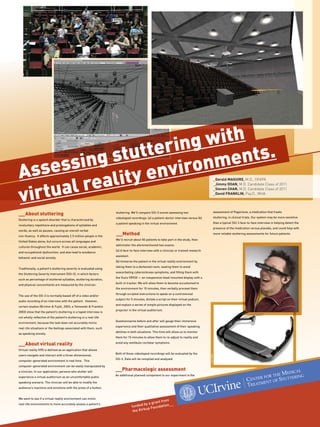
VR poster opt 2
- 1. __About stuttering Stuttering is a speech disorder that is characterized by involuntary repetitions and prolongations of syllables and words, as well as pauses, causing an overall verbal non-fluency. It affects approximately 2.5 million people in the United States alone, but occurs across all languages and cultures throughout the world. It can cause social, academic, and occupational dysfunction, and also lead to avoidance behavior and social anxiety. Traditionally, a patient’s stuttering severity is evaluated using the Stuttering Severity Instrument (SSI-3), in which factors such as percentage of stuttered syllables, stuttering duration, and physical concomitants are measured by the clinician. The use of the SSI-3 is normally based off of a video and/or audio recording of an interview with the patient. However, certain studies (Brinton & Fujiki, 2003; a Tetnowski & Franklin 2003) show that the patient’s stuttering in a taped interview is not wholly reflective of the patient’s stuttering in a real-life environment, because the task does not accurately mimic real-life situations or the feelings associated with them, such as speaking anxiety. __About virtual reality Virtual reality (VR) is defined as an application that allows users navigate and interact with a three-dimensional, computer-generated environment in real time. This computer-generated environment can be easily manipulated by a clinician. In our application, persons who stutter will experience a virtual auditorium as an uncomfortable public speaking scenario. The clinician will be able to modify the audience’s reactions and emotions with the press of a button. We want to see if a virtual reality environment can mimic real-life environments to more accurately assess a patient’s stuttering. We’ll compare SSI-3 scores assessing two videotaped recordings: (a) a patient-doctor interview versus (b) a patient speaking in the virtual environment. __Method We’ll recruit about 50 patients to take part in the study, then administer the aforementioned two exams: (a) A face-to-face interview with a clinician or trained research assistant. (b) Immerse the patient in the virtual reality environment by taking them to a darkened room, seating them to avoid exacerbating cybersickness symptoms, and fitting them with the Vuzix VR920 — an inexpensive head-mounted display with a built-in tracker. We will allow them to become accustomed to the environment for 10 minutes, then verbally proceed them through scripted instructions to speak on a controversial subject for 5 minutes, dictate a script on their virtual podium, and explain a series of simple pictures displayed on the projector in the virtual auditorium. Questionnaires before and after will gauge their immersive experience and their qualitative assessment of their speaking abilities in both situations. This time will allow us to monitor them for 15 minutes to allow them to re-adjust to reality and avoid any vestibulo-cochlear symptoms. Both of these videotaped recordings will be evaluated by the SSI-3. Data will be compiled and analyzed. __Pharmacologic assessment An additional planned component to our experiment is the assessment of Pagoclone, a medication that treats stuttering, in clinical trials. Our system may be more sensitive than a typical SSI-3 face-to-face interview in helping detect the presence of the medication versus placebo, and could help with more reliable stuttering assessments for future patients. VuzixVR920 VuzixVR920demonstration funded by a grant from the Kirkup Foundation__ CENTER FOR THE MEDICAL TREATMENT OF STUTTERING _Gerald MAGUIRE, M.D., DFAPA _Jimmy DOAN, M.D. Candidate Class of 2011 _Steven CHAN, M.D. Candidate Class of 2011 _David FRANKLIN, Psy.D., MHA Assessing stuttering with virtual reality environments.
